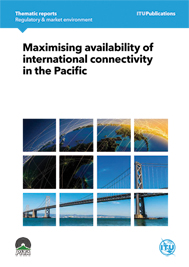 | 2018
This report builds on the 2017 ITU Report Maximizing availability of international connectivity in developing countries; strategies to ensure global digital inclusion, and a workshop, Enhancing Access to submarine cables for Pacific Island Countries, organized together with the Pacific Island Telecommunications Association, with support from the Department of Communications and the Arts, Government of Australia, and the Department of Communications, Government of Fiji, to undertake a stock take of the existing and planned submarine cables connecting the Pacific Islands, provide some illustrative case studies, and identify common challenges for submarine cable projects in the Pacific Islands. |
| | Available in | 
|
| |
|